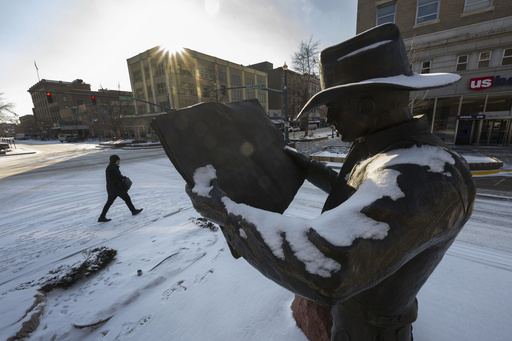Storms have unleashed significant snowfall and freezing rain across a large section of the eastern United States, affecting areas from Kentucky to Washington, D.C. The severe weather resulted in numerous traffic incidents, widespread power outages, and the potential for flooding as temperatures started to rise on Wednesday.
The storm system, which traveled from Kentucky to Maryland and beyond, deposited over 14 inches (37 cm) of snow in Iron Gate, a small Appalachian town in western Virginia, and 12 inches in White Sulphur Springs, West Virginia, roughly 65 miles (105 km) to the west, according to the National Weather Service.
As of Wednesday, more than 190,000 residents in Virginia and close to 10,000 in North Carolina were without electricity, as reported by PowerOutage.us. Appalachian Power, which supplies electricity to about a million customers in West Virginia, Virginia, and Tennessee, mentioned that they had deployed 5,400 workers for power restoration efforts.
Air travel has also suffered, with several inches of snow reported at regional airports. Scott Kleebauer, a meteorologist at the Weather Prediction Center, noted that the recent bout of weather contrasts sharply with a generally calm few seasons prior.
On Wednesday, nearly 2,500 flights across the nation faced cancellations or delays, including approximately 200 flights into Ronald Reagan National Airport in the D.C. area, according to FlightAware.com.
Schools in Virginia were closed for a second consecutive day, and educational institutions in both the Baltimore and Washington, D.C. regions also canceled classes for the day.
As temperatures are expected to rise by Wednesday afternoon, the mix of snow and ice could transform into rain, raising concerns about flooding as accumulated rainwater and melting snow feed into rivers and streams that are already swollen from recent storms. The National Weather Service has issued a flood threat extending from eastern Tennessee to southwestern Virginia and beyond through Thursday morning.
“Our primary concern as we move into Thursday will be the potential for flooding as rivers and streams rise due to melting snow and rain occurring simultaneously,” explained Vance Joyner, a meteorologist from the National Weather Service in Blacksburg, Virginia.
Numerous accidents occurred in Kentucky due to snow-covered roads, including a tragic head-on collision in Nelson County that claimed a driver’s life when they lost control and collided with a semi-truck. In Virginia, where the governor declared a state of emergency, police reported around 850 accidents over Tuesday and Wednesday, with several resulting in injuries. However, it remains uncertain whether the weather conditions were directly responsible for those accidents. Maryland State Police recorded 235 collisions and noted 185 vehicles that were inoperable or unattended.
The wintry chaos extended westward, with another storm system expected to deliver heavy snow from Oklahoma all the way to the Great Lakes. Consequently, government offices were shuttered in certain areas of Oklahoma, Kansas, and Missouri, and several universities in these states as well as Iowa called off classes.
On the West Coast, Multnomah County in Oregon has extended its state of emergency at least through Thursday, with five emergency shelters open as wind chill factors in Portland could plunge to 10 degrees Fahrenheit (minus 12 degrees Celsius).
Meanwhile, California is preparing for another atmospheric river phenomenon. This significant weather pattern, which transports moisture from more tropical regions to northern areas, is anticipated to make landfall late Wednesday, threatening to flood cities and suburbs throughout central and Southern California, where heavy snowfall is also expected in the Sierra Nevada. The California Department of Water Resources reported that over 700,000 sandbags have been distributed in preparation for possible flooding throughout the affected regions.




